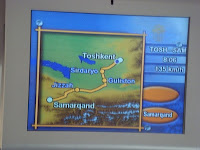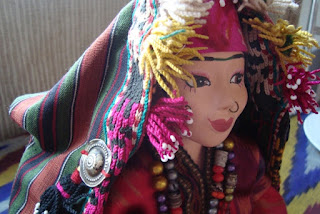March 13, 2012
Today started as a sunny day, and as I missed my outing yesterday, I decided to join Robert in the taxi that brings him to the office at 08:30, in order to investigate the area behind the office. There is a mosk and “the” big food market, and I might walk back. I didn’t walk in the end as I bought too much and that was heavy. There were all sorts of things that I hadn’t found up to then: laurel leaves, ground red chili pepper, and other spices.
The office must have been a nice building once upon a time, with nicely laid out wooden floors. It is a bit deteriorated now, but well, his office room is not bad at all: a room with a view! I was introduced to the Uzbek deputy team manager, a very friendly gentleman our age.
Fresh bread is being sold in huge quantities! And tortlar (tort is for cake and lar is the plural) was offered to me” 3 pieces for only 5000 Cym, which is 1,50 euro
 Before I come to the actual open food market on the first floor, there are some interesting boutiques on ground level: the wool & embroidery shop is really crowded – would all those women do so many handicrafts at home? There are also very kitsch type materials for sale. In the other stores and in the market, only men do the buying.
Before I come to the actual open food market on the first floor, there are some interesting boutiques on ground level: the wool & embroidery shop is really crowded – would all those women do so many handicrafts at home? There are also very kitsch type materials for sale. In the other stores and in the market, only men do the buying.
 The market is very spacey and airy, and feels very safe. People don’t bother me, but they do look at me,
The market is very spacey and airy, and feels very safe. People don’t bother me, but they do look at me, as I am obviously a foreigner, taller and blond
(well lets say that grey looks blond too J).
 There are women sitting on the stairs selling fresh green herbs only. For amazingly low prices: 200 Cym for one bunch of coriander, which is 5 cents! Before I take pictures I ask the people involved if I may. This usually leads to interesting dialogues (I am afraid not in Uzbek yet) about where I come from (Golandya), and then the men mention Ajax and Feyenoord; I manage to say thank you (rahmat!) and wish them a very good day:
There are women sitting on the stairs selling fresh green herbs only. For amazingly low prices: 200 Cym for one bunch of coriander, which is 5 cents! Before I take pictures I ask the people involved if I may. This usually leads to interesting dialogues (I am afraid not in Uzbek yet) about where I come from (Golandya), and then the men mention Ajax and Feyenoord; I manage to say thank you (rahmat!) and wish them a very good day:
Kunigiz Yachshi Ustin.
The Friday mosk I didn’t dare enter as a woman. But is looks quite nice from the outside
The cafeteria looks quite festive, Chinese influence?
 The name of the city alone recalling associations with 1001 night, sensual, silk road centre of wisdom and trade. We had a lovely small hotel, way beyond the big tourist group sort of thing, privately owned and recently redone.
The name of the city alone recalling associations with 1001 night, sensual, silk road centre of wisdom and trade. We had a lovely small hotel, way beyond the big tourist group sort of thing, privately owned and recently redone.  With a beautiful view on the famous Bibi-Ghanum mausoleum. Bibi being the Chinese princess, wife of Emir Timur, the big boss here in the 14th centur. Timur the Lame, better known as Timurlane. He is the guy that inspired all those beautiful buildings, both Madrassas (universities, we would call them, learning centres where students had their own cells) and mausoleums where his family and dear ones were buries. Interesting to see those buildings of a scale unknown till then, at the same time that we- in
With a beautiful view on the famous Bibi-Ghanum mausoleum. Bibi being the Chinese princess, wife of Emir Timur, the big boss here in the 14th centur. Timur the Lame, better known as Timurlane. He is the guy that inspired all those beautiful buildings, both Madrassas (universities, we would call them, learning centres where students had their own cells) and mausoleums where his family and dear ones were buries. Interesting to see those buildings of a scale unknown till then, at the same time that we- in 
























































